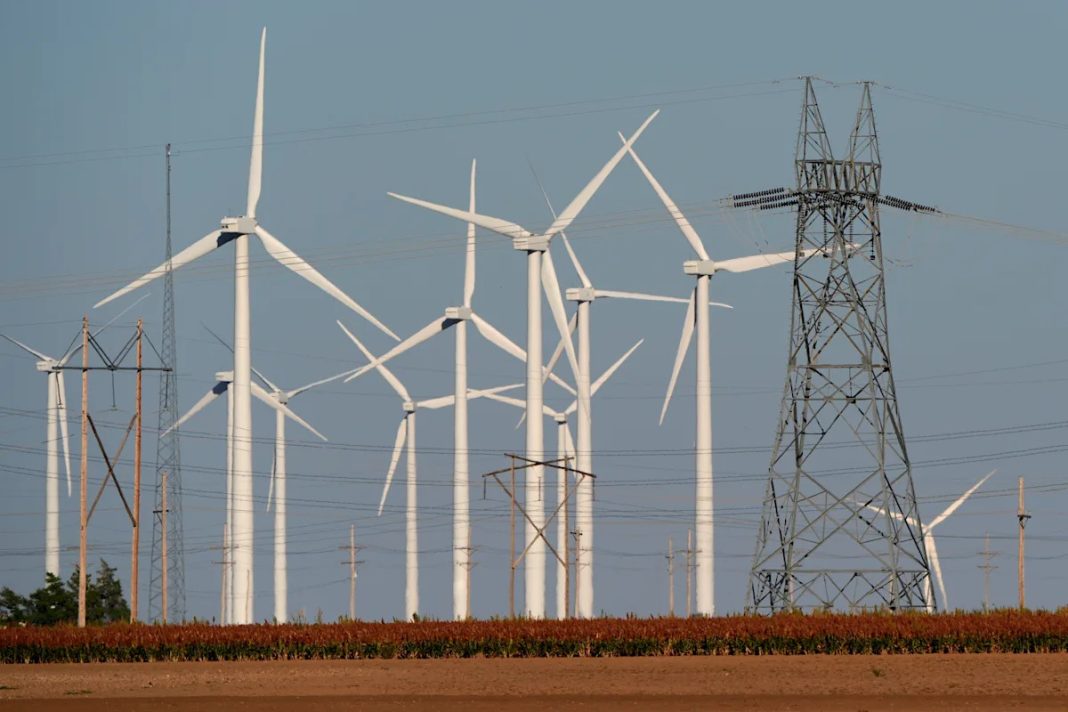President Donald Trump has promised to super-charge the U.S. electricity network to win the global race for artificial intelligence — but his administration is rejecting efforts to get that power from solar or wind.
The latest example came Wednesday, when the Energy Department said it terminated a pending $4.9 billion loan guarantee for the Grain Belt Express project, an 800-mile transmission line that would carry mostly wind-generated power from the Plains to some of the most strained parts of the nation’s power grid.
The announcement came on the same day that the administration outlined its plans to dominate the AI sector, including by expanding the grid, which it called“the lifeblood of the modern economy and a cornerstone of national security.”
Though thoroughly in line with Trump’s explicit preference for fossil fuels and nuclear power, the cancellation of the Biden-era loan guarantee left some power sector experts, business leaders and lawmakers on both sides of the aisle baffled. Killing the loan guarantee, they said, would directly contradict Trump’s goals of shoring up the power grid, cutting electricity bills and delivering power to new AI data centers.
“You can’t have it both ways,” said Republican Sen. Thom Tillis of North Carolina. “If you can’t transmit electrons reliably and efficiently, then you’re not going to have energy-intensive industries relying on it.”
The White House declined to comment on the cancellation. In a statement, an Energy Department spokesperson said the department will “continue to use all tools at its disposal, including the Loan Programs Office” to support projects that “advance reliable, affordable, and secure energy sources, strengthen the grid and lower costs for the American people.”
Conservative Missouri Sen. Josh Hawley has long sought to block the Grain Belt Express project and said recently that Trump assured him the administration would yank the loan guarantee. Farmers, particularly in Missouri and Illinois, have resisted the project’s use of eminent domain to obtain the needed land and argued they wouldn’t see the benefits of the line in their states.
In an interview Wednesday, Hawley said he was “not really” concerned the project would undermine the administration’s AI effort because “Missouri was gonna get just about nothing” from the project.
“They’ve taken farmers to court in order to seize their land, and all of that for wind power, which is totally unreliable,” said Hawley, who laid out his argument to Trump and Wright during a White House meeting earlier this month.
Trump, however, has touted the use of eminent domain to build projects in his real estate portfolio and, during his first term, wielded that power to build a wall along the U.S. southern border and backed its use for pipelines like the now-defunct Keystone XL pipeline project.
“Without any eminent domain you wouldn’t have any highways, you wouldn’t have any schools, you wouldn’t have any roadways,” he said in 2019. “If we can’t make a deal, we take the land and we pay them through a court process … otherwise you could never build anything.”
The Energy Department said it canceled the Grain Belt Express loan guarantee because it was “not critical for the federal government to have a role in supporting” the project, and that the conditions necessary to issue the guarantee were “unlikely to be met.”
“To ensure more responsible stewardship of taxpayer resources, DOE has terminated its conditional commitment,” the department said.
Missouri Attorney General Andrew Bailey, who openeda civil investigation into the project earlier this month, called the decision a win in “a major battle in the war for Missouri private property rights and farmers.”“At our urging, the DOE saw this boondoggle for what it was, pulled the plug on nearly $5 billion in taxpayer-funds, and Missouri families are better off for it,” Bailey said in a statement.
But the project’s backers point out that the U.S. is badly in need of new transmission, especially the type that connects regional grids. Grain Belt Express is designed to connect four of those grids. It already received permits from the four states that it would cross and is set to begin construction next year.
The line would run from western Kansas, where excess wind power is clogging the grid, to Missouri, Illinois and Indiana, where electricity demand is soaring. When the Plains grid is under strain from extreme weather, the line could reverse direction and carry power the other way.
Rep. Sean Casten (D-Ill.), a former clean energy developer, said killing the project would be “the biggest own-goal by an administration that says they’re committed to building out transmission.”
“If the purpose of U.S. energy policy is to benefit consumers, that’s a no-brainer, right?” he said.
Chicago-based Invenergy, which is developing Grain Belt Express, has tried to appeal to Trump by painting the project as an opportunity for him to secure a major win where the Biden administration could not — completing a project that would advance the key pillars of his energy agenda. Earlier this year, the White House touted the project among its “wins” for American investment.
And while the line has largely been marketed as a boon for wind power, Invenergy has pivoted and is now looking to connect a new gas plant and possibly existing coal generation to the line.
In a statement Wednesday, a project spokesperson signaled the company would continue to pursue the project — albeit without the government financing.
“While we are disappointed about the LPO loan guarantee, a privately financed Grain Belt Express transmission superhighway will advance President Trump’s agenda of American energy and technology dominance while delivering billions of dollars in energy cost savings, strengthening grid reliability and resiliency, and creating thousands of American jobs,” the spokesperson said.
The Grain Belt Express would be able to carry more than 5 gigawatts of power — enough to power 50 of Trump’s new data centers, Invenergy has said. It projects that U.S. consumers in 29 states would save a combined $52 billion on their energy bills if it is built.
Energy Secretary Chris Wright has also backed the need for new electricity transmission, even as he has taken aim at renewable energy.
In a hearing last month before House lawmakers, Wright testified that “there’s no doubt that our country and our grid would benefit from more transmission,” adding that the historical record of building transmission lines in the U.S. is long and “incredibly hard.”
The AI Action Plan released by the White House on Wednesday calls for expedited permitting to speed the development of new infrastructure, while making federal lands available for data center and power generation infrastructure construction. It also recommends implementing changes to enhance the efficiency of the existing transmission system.
At a Senate hearing on rising power demand on Wednesday, Sen. Angus King (I-Maine) noted that increasing transmission has been a centerpiece of Washington discussions.
“Unfortunately, this morning, the Department of Energy terminated a loan program for a major interregional transmission system in the Midwest. So here we are talking about how important transmission is… I just think the timing is somewhat ironic,” King said.
The Energy Department and the North American Electric Reliability Corp., the nation’s grid reliability watchdog, have warned that the U.S. needs thousands of miles more transmission lines to keep pace with demand. But permitting and financing delays have stymied construction — last year, the U.S. built just 322 miles of high-voltage lines, according to a report this week from power grid consultancy Grid Strategies and advocacy group Americans for a Clean Energy Grid.
Two of the regional grids connected to the Grain Belt Express are facing particularly dire futures as demand skyrockets without enough new generation to keep up. One of them is the Midcontinent Independent System Operator, whose territory stretches from the upper Midwest to Louisiana, and the other is PJM Interconnection, which includes 13 states from Illinois to the East Coast.
These trends have driven up prices and choked off new industrial development, particularly of power-hungry data centers and manufacturing facilities.
Ray McCarty, president and CEO of Associated Industries of Missouri, a trade group representing many of the state’s largest businesses, said some of his members are already losing deals to build data centers because they cannot guarantee the electricity needed to power them — something Grain Belt Express would help to address.
“This is something that’s available in the very near term — something we can do right away to help move toward that end goal of making America a leader in data centers and artificial intelligence,” he said. “We do think that it does align perfectly with making America first.”
Rep. Erin Houchin, an Indiana Republican, also backed the project in a statement to POLITICO on Wednesday, noting that China is rapidly building out the transmission infrastructure “critical to winning the AI race.”
“Expanding and modernizing our transmission infrastructure is essential to advancing President Trump’s vision for American energy dominance, driving economic growth, and reducing energy costs in states like Indiana,” Houchin said.
Even without the demand from potential data center growth, experts and industry officials say MISO and PJM need more capacity to rein in rising energy prices and reduce the risk of blackouts.
Steve Stodden, president and CEO of the Missouri Public Utility Alliance, which represents municipal utilities across the state, said many of his members are scrambling to deal with rising wholesale power prices.
To avoid passing on those increases to customers, the cities have been looking to the Grain Belt Express to bring in cheaper power from Kansas. The group negotiated prices with Invenergy several years ago that are “very lucrative” compared with the rates now, Stodden said.
If the project isn’t built, the cities will likely need to shell out for new gas-fired power plants, whose construction prices have surged because of tariffs and supply chain constraints.
“Any megawatts you don’t have to build right now are good megawatts not to build because everything is just so expensive right now,” Stodden said.
Some Republicans argue, however, that Grain Belt Express was not the right project to expand the transmission network.
“We need to have good transmission, reliable, to provide electricity needs across the country,” said Rep. Ron Estes (R-Kansas). But he said Invenergy’s “land grab” for the project was “inappropriate,” and he urged broader changes to permitting rules to speed the development of the high-voltage lines.
The move comes as the administration has taken other steps to stunt wind and solar development, including its recent executive order designed to limit the ability of those projects to access tax incentives under the GOP megalaw and an Interior Department directive adding obstacles to wind and solar development.
The Biden administration announced its intent to offer the loan guarantee to Grain Belt Express in the final months of the former president’s term. Wright has repeatedly criticized the Biden administration’s actions on billions of dollars of loans in its waning days but has said the loan office can play a vital role in supporting certain projects such as nuclear and critical minerals.
DOE said Wednesday that it is conducting a review of the loan office’s portfolio, including the closed loans and conditional commitments made between Election Day 2024 and Trump’s inauguration to ensure that taxpayer dollars are being used to “advance the best interest of the American people.”
Josh Siegel and Isa Domínguez contributed to this report.

